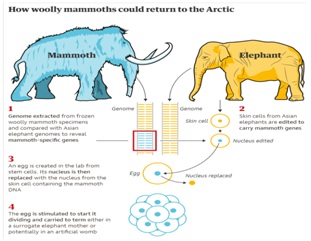

Context
Scientists are planning to bring the woolly mammoth back to life with the help of CRISPR gene-editing technology to insert an extinct mammoth’s DNA into the genome of an Asian elephant.
About
About the species
- Woolly mammoths went extinct around 4,000 years ago at the end of the last “ice-age”.
|
Ice Age
|
- They may have died off when the weather became warmer and their food supply changed.
- Their ears were smaller than those of today’s elephants. This was probably an adaptation to the cold climate that kept their ears closer to their heads and kept them warmer.
- Their tusks were very long, about 15 feet (5 meters) and were used for fighting and digging in the deep snow.
- Mammoths were herbivores and ate mostly grass, but also ate other types of plants and flowers.
The process
- The DNA, collected from mammoth tusks, bones and other preserved body parts found in ice, will be sequenced to create an “elephant-mammoth hybrid”.
- It would look like a furrier, larger elephant with smaller ears and a high-domed head.

What is Genome editing?
- Genome editing or gene editing is a group of technologies that give scientists the ability to change an organism's DNA.
- These technologies allow genetic material to be added, removed, or altered at particular locations in the genome.
- Several approaches to genome editing have been developed.
- A recent one is known as CRISPR-Cas9, which is short for clustered regularly interspaced short palindromic repeats and CRISPR-associated protein 9.
|
Asian elephant
|



